Everything you need to know about the ultimate bucket list experience: Gorilla trekking

We’ve climbed mountains, ziplined through jungles, scuba dived with manta rays, camped in a safari park in Rwanda, gone shark diving in South Africa, and chased sunsets across the globe (humble brag, don’t mind me).
But we can say with confidence that gorilla trekking in Uganda was hands-down the most epic thing we’ve ever done.
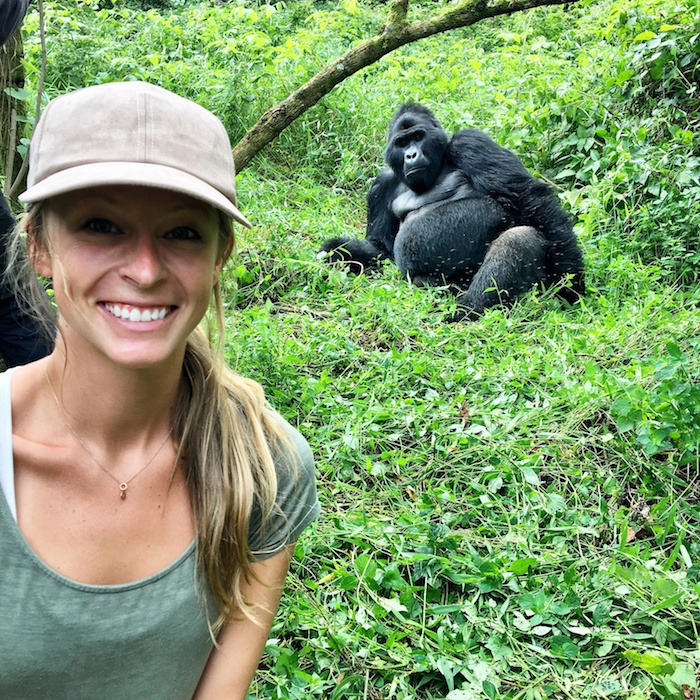
Silverback photobomb in Uganda. (Kellie Paxian / Daily Hive)
If this was not on your bucket list already, it will be by the end of this article. And we’re going to tell you exactly how to make it happen!
Here is your ultimate guide to checking gorilla trekking off your list.
What’s all the hype about?
There is something both fascinating and humbling about getting up close and personal with such a closely related species in their natural habitat.
Gorillas are the largest and strongest primates in existence and are 98% genetically identical to humans. They make eye contact with you in a way that feels like they are seeing into your soul. Their movements and features are so humanlike that watching them is like peering into a page of evolution itself.
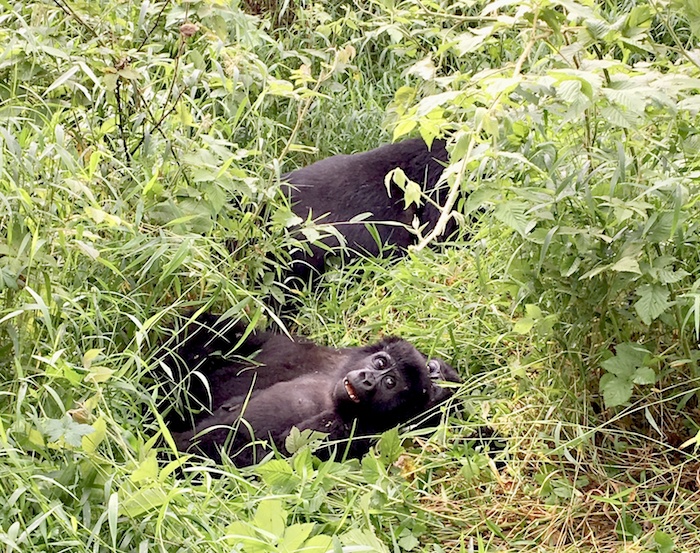
Expressive young gorilla. (Kellie Paxian / Daily Hive)
Gorillas’ ears and hands are shaped just like ours. You can watch as they climb and swing from the trees, selectively pick leaves off branches, roll around in the grass and playfully wrestle with their family members. They use their hands to dig through the bush for that perfect leafy branch, reach their arms around to scratch their back. We saw one pick their nose with their finger. They are essentially giant, leathery black, hairy versions of humans.
As far as we’re concerned, the main difference between gorillas and humans is that if they wanted to, they could crush us with their pinkie finger.
Gorillas are fascinating creatures and having the opportunity to be in their presence, in a jungle in Africa, is the most inspiring adventure.
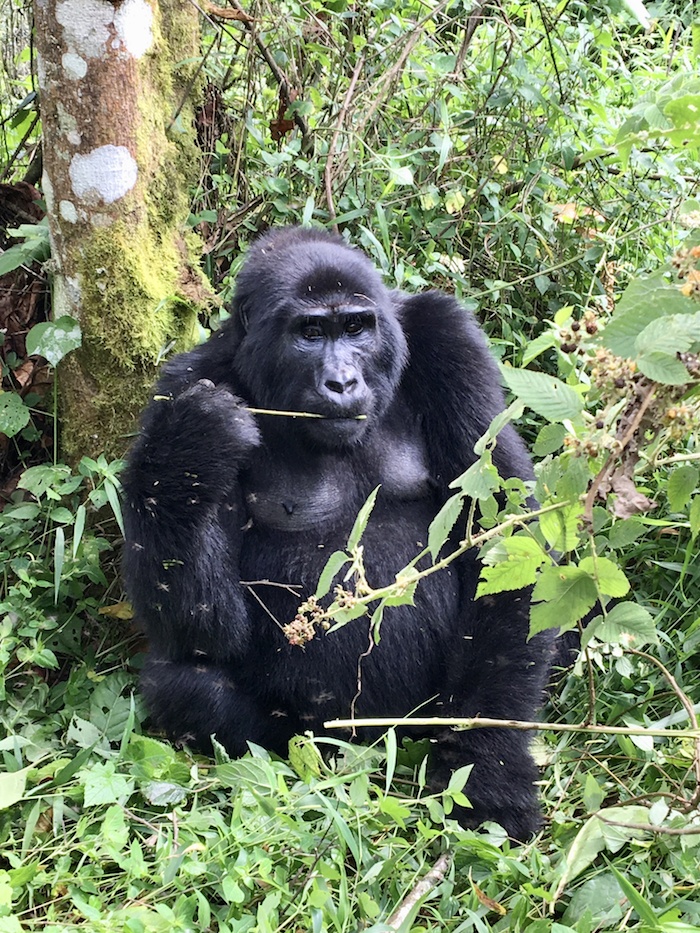
Gorilla in Bwindi National Park, Uganda. (Kellie Paxian / Daily Hive)
Where do I go?
Mountain gorillas only exist in the Virunga Mountain range, which stretches across the following regions:
- Volcanoes National Park in Rwanda
- Bwindi National Park or Mgahinga Gorilla National Park in Uganda
- Virunga National Park in the Democratic Republic of Congo
How much does it cost?
Gorilla trekking ain’t cheap. Here’s what this epic experience will set you back in each region.
- Rwanda: $1,500 USD
- Uganda: $650 USD in peak season (June, July, August, September, early November, December, January and February) and $450 USD in the offseason
- Democratic Republic of Congo: $200 USD
The tourism dollars go towards conservation of the gorillas and their surrounding habitat, as well as providing an income for nearby villages such as porters, rangers, hotel and restaurant staff. If it weren’t for this funding, it is highly likely that the gorillas’ habitat would be cut down and turned into farmland. These conservation efforts appear to be working, as the latest census shows that the population of mountain gorillas is currently growing (yay!).

Silverback gorilla. (Kellie Paxian / Daily Hive)
How do I book?
Spots for gorilla trekking fill up in advance (because did we mention it’s the coolest experience EVER?) so we recommend booking ASAP.
You can book through a tour guide like Gorilla Walkers Uganda, which will include transportation and accommodation but also a booking fee. If you’re looking to save a few bucks, it’s best to book the permit yourself — we went through the Ugandan Wildlife Authority. Uganda was the most appealing option because it is more affordable than Rwanda, and we weren’t quite adventurous enough to visit the Congo.
If you book the permit on your own you will also have to arrange accommodation. In Uganda, we stayed at the Bwindi Backpackers Lodge, which is a decent budget option but certainly not luxury. It’s advisable to find an accommodation that will hook you up with transportation from the nearest town – for example, Kibale in Uganda – because it’s a two-hour bumpy ride to the forest!
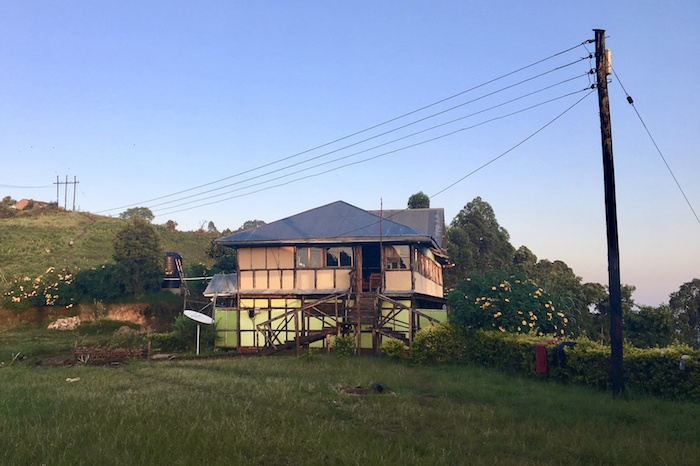
Bwindi Backpackers Lodge in Uganda. (Kellie Paxian / Daily Hive)
What do I pack?
First off – WATER. You are trekking through the jungle in Africa and you’re gonna get thirsty. Also, bring snacks such as crackers or a granola bar for an energy boost.
You will want to wear high hiking boots — you are trekking through the thick jungle bush that can be knee-high (or higher), and there is no path other than the one your guide just chopped in front of you with their machete. Also, make sure your boots have a good grip, as it can be very slippery especially during the rainy season.
Pack layers including a light rain jacket, as you never know what the weather will be.
In terms of colours, you think the neutral safari colours are a cliché but they actually serve a purpose. The reason for these colours is to avoid the dreaded tsetse fly, which is attracted to bright or dark colours – in particular, stay away from blues and blacks.
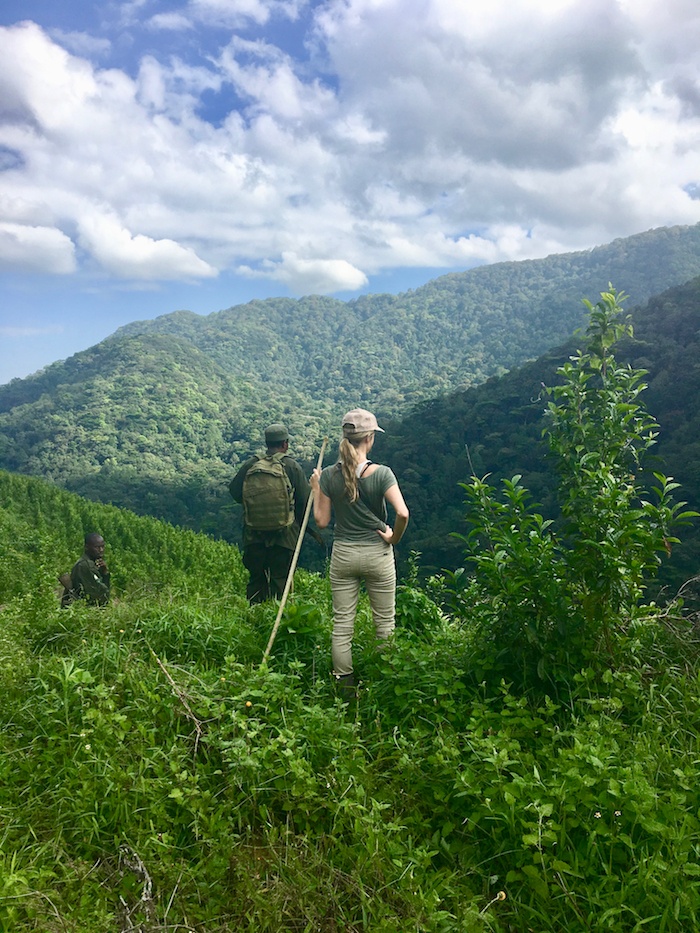
Trekking in Bwindi Impenetrable Forest. (Kellie Paxian / Daily Hive)
How long does it take?
It depends on where the gorillas are! You hike to wherever the family is currently situated in their natural habitat, as guided by the trackers on their walkie-talkies. It can take anywhere from two to eight hours, depending on where the gorilla family is at the time of your meeting as they are constantly moving.
Trekking time spans from 8:30 am to 7:00 pm, when it starts to get dark. On the very rare chance that you don’t make it to the gorillas that day, you will get your money back.
What is the breakdown of the day?
You will be divided into a trekking group according to your age and fitness level (that being said, we were in a group of German people aged 65+ so this must depend on the demand). There will be a maximum of eight people per trek, so needless to say, you will want to book ahead of time!
In your group, you will listen to a briefing for just over an hour to learn about the gorillas and their habitat, as well as how to act around them.
During this time, the trackers will set out in the jungle to locate the gorillas ahead of time and direct your group via radio.
Our tour was through the Nkuringo area of Bwindi Impenetrable Forest (show us a more badass name than Impenetrable Forest — we’ll wait), where there were two gorilla families living. We set out to find the group of 12 individuals.
The trek is definitely not easy — the brush is thick, and the slope is vertical at times. You will have been given a walking stick, which is literally critical to getting through some parts. Your alternative is probably just sliding down the hill on your butt, which is not recommended (or allowed).
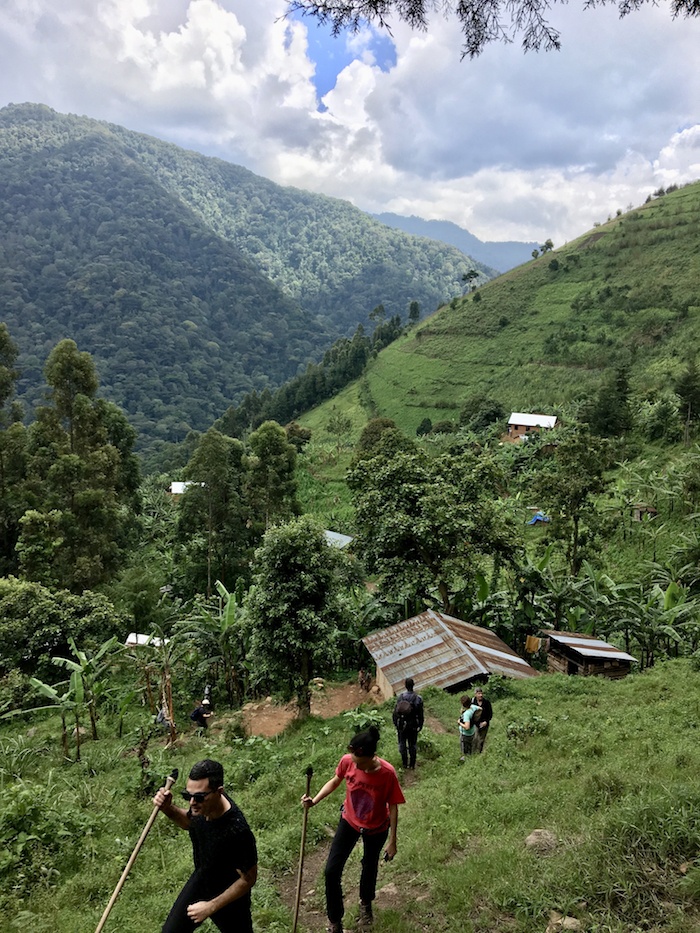
Trekking for gorillas in Bwindi National Park. (Kellie Paxian / Daily Hive)
You’ll pass through a few tiny villages amongst banana trees, tea plants, and other crops. Just casually living in a village with gorillas in your backyard. No big deal. The gorillas dislike the smell and taste of the tea plants, which encourages them to stay within the park instead of venturing into an angry farmers’ crops.
You will trek through the jungle until your trackers signal that you are near gorillas. You will be with a certified guide as well as several officers with AK47s in the front and rear of the group.
Eventually, you’ll come to a point where you start to sense that the gorillas are near. You will see some of the bush has been flattened, and you may see swinging in the tree. Then you’ll see some black hair through the branches.

Gorilla in a tree in Uganda. (Kellie Paxian / Daily Hive)
Then you will stash your bags and walking sticks with one of the trackers, and observe.
You’ll get to stay with the gorillas for one hour, before trekking back up the mountain — pinching yourself at what you just experienced.
Is it safe?
Gorillas are not innately aggressive creatives, although they have been influenced by years of hunting, so it takes time to build up trust. They may be inclined to show aggression if they feel they or their babies are being threatened. Like any wild animal, they can be unpredictable and you must be respectful of their space and not get too close. This goes without saying, but obviously do not touch them!
Listen to what your guides tell you — they do this every day and know the gorillas best.
Your guide has an AK-47 with them, but this is not to shoot and kill the gorillas. If one of the animals were to show signs of aggression, the guide would shoot into the air to create a distraction and deter the gorilla from charging.
If a gorilla is coming towards you, you are advised to not make eye contact and slowly move backwards.
If you’re like my mom, you may have some concerns around trekking through an impenetrable jungle in Africa, flanked by guards holding rifles and machetes, to chill with 400-pound gorillas. However, the entire experience felt 100% safe and we would recommend it to anyone who is up for an adventure.
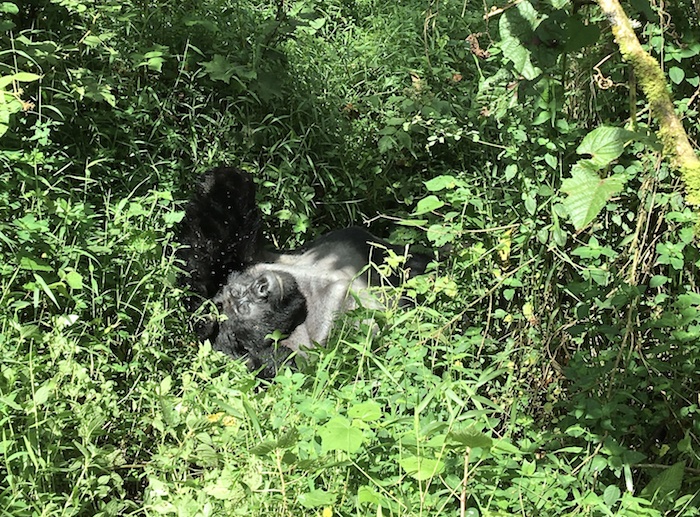
Gorilla basking in the sun. (Kellie Paxian / Daily Hive)
Are gorillas endangered?
According to a recent joint census by the governments of Uganda, Rwanda, and the Congo, there are only 880 mountain gorillas left in the world, making them a critically endangered species.
However, a piece of good news — this is higher than the 700 that were counted in the previous census, and officials are optimistic that the number will continue to increase.
Can we get some fun gorilla facts up in here?
Size: 1 – 2 metres tall (4 – 6 feet)
Weight: Adult males are 300-475 pounds; adult females weigh 150-250 pounds
Strength: About 20 times strong than humans
Age: Up to 40 or 50 years
Life cycle: Females can produce offspring starting at age 10, can carry one or two babies at a time and have a gestation period of about 8.5 months. They tend to bear two to six babies in a lifetime.
Movement: Rely on their arms for strength and walk around on their knuckles
Diet: Herbivorous, consuming leaves, shoots, stems, and roots. Adult males eat 40 – 50 lbs of food per day, while the females eat slightly less. Water intake is minimum as they hydrate from the plants they consume.
Lifestyle: Gorillas travel in families of approximately three to 30 individuals, led by their fearless leader — the alpha male of the group — a fully mature silverback. Fun fact: He actually has grey hair on his back, hence the name! There may also be a secondary male, along with the females and babies. Their family dynamic and relationships are much like humans as they meander through the forest.
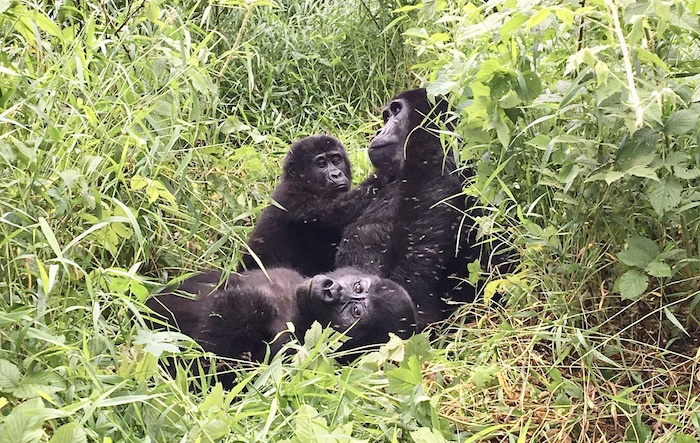
Gorilla family in Bwindi National Park, Uganda. (Kellie Paxian / Daily Hive)
Now it’s our turn to ask the question:
What are you waiting for?!
Have any other questions about gorilla trekking? Or want to share your own experience – gorilla-related or otherwise? Leave a comment below or email us at [email protected].

